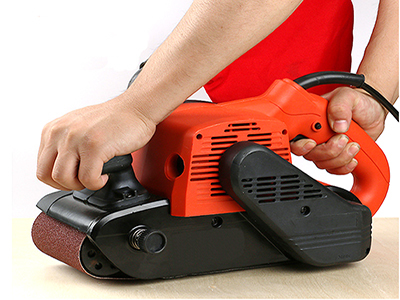Belt sander is a powerful electric tool commonly used in industrial, commercial and personal projects. Belt sander is usually suitable for roughing to finishing processing stage. However, only professional woodworkers with rich experience can use belt sander for finishing, and beginners are more suitable for roughing. Compared with electric saws or electric drills, belt sander is safer, but there are still many things to pay attention to when using it.
Preparations before using belt sander
Before using belt sander, first check whether it can run normally. Check the parts, sanding belt, pad and other positions of the belt sander, and make sure that there is no dust or other impurities that may hinder the normal operation of belt sander.
Belt sander will produce a lot of noise when running. If you use it for a long time, your hearing may be damaged, so you always need to take measures to protect your ears. In addition, the belt sander will blow out dust from all sides, and may also fly out wood debris, injuring your face and eyes. Therefore, it is recommended that you wear an eye mask and a protective mask when operating the belt sander (the mask can also prevent dust inhalation).
How to use the belt sander?
After starting the belt sander, wait for it to reach the maximum speed before starting the sanding work. After reaching the maximum speed, you can slowly adjust the speed for the belt sander as needed.
Note that when sanding softer woods with a belt sander, lower speeds are better, while hard woods are better for higher speeds. Regardless of whether you are using high speed or low speed, always use both hands to operate the belt sander to maintain stability.

Beginners should pay special attention when using belt sander for the first time. If the effect is not satisfactory after a sanding, please do not apply force by your body weight on the machine. If too much pressure is applied, it may cause adverse effects and destroy the processing effect. If you use belt sander to finish wood, please slowly increase the grade of grit.
In the process of using belt sander, users usually do not have much time to check the sanding depth frequently, so you'd better use a pencil to mark the areas that have been sanded.
If you use the belt sander for stationary sanding, an reverse clamp can be used to place the belt sander upside down on the workbench. This method is particularly suitable for sanding smaller wood or wood edges, and can also be used in rough sanding and sharpening for tools. However, please always remember that this flip sanding method is not suitable for beginners because it cannot ensure complete accuracy and precision.
Things to do after using belt sander
- Unplug the power cord. It is recommended to wind the wires well to avoid tangles and easy to store.
- Clean up the work site. Clean up the used sanding belt or sandpaper, and clean up dust and impurities accumulated during work. This helps to extend the life of belt sander.
- Store the belt sander in a dry, constant temperature and safe place.
Tips for using belt sander
- Operate belt sander by both hands. When operating the belt sander, place one hand on the handle to keep it stable, and the other hand to operate the trigger. Both hands should be kept in the same position during the entire use. Put the belt sander on the material to be sanded, first touch the rear of belt sander to the material, and then put down the belt sander completely. The sanding belt in motion will cause the belt sander to move forward by itself on the material surface, so please ensure that it always maintain a good grip.
- When sanding, always move the belt sander along the texture of material. Be careful not to keep the belt sander still for a long time, otherwise it may cause cracks or stains. Because the belt sander has high speed and powerful functions, it will not take much time to remove a large amount of surface material.
- Stationary sanding. Stationary sanding is suitable for applications that require materials to form angles or other shapes, although this is not the most accurate sanding method. Using the vise installed on the workbench, place the belt sander vertically and fix it. Then start the belt sander, you can move the material freely and sand out the desired shape.

